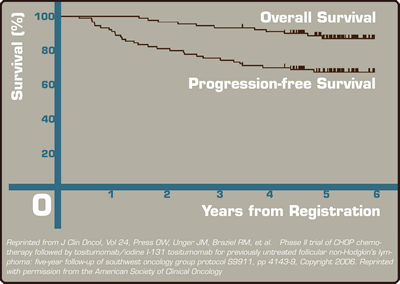An optimal therapeutic strategy for initial treatment of follicular lymphoma remains undefined. In this paper, Press and colleagues have updated the findings of the SWOG 9911 study of sequential CHOP chemotherapy (cyclophosphamide, doxorubicin, vincristine, prednisone) followed by radioimmunotherapy (RIT) with the anti-CD20131I-tositumomab regimen (Bexxar™). Ninety eligible patients were treated with six cycles of standard-dose CHOP followed by restaging four to eight weeks after cycle six. RIT was then administered for those achieving a partial or complete response, using the standard 131I-tositumomab treatment protocol. Ninety-six percent of patients had stage III-IV disease, 27 percent had “B” symptoms, 23 percent had bulky adenopathy > 10 cm, and 65 percent had intermediate- or high-risk FLIPI scores. Eighty-six of the patients completed CHOP therapy, and 77 (90 percent) of these completed RIT1 . The complete response rate improved from 39 percent following CHOP to 69 percent following RIT; 22 percent achieved partial response. With 5.1 years median follow-up, the estimated five-year progression-free survival rate is 67 percent and overall survival is 87 percent. Acute toxicities included expected levels of transient cytopenias following each phase of therapy. Late toxicities have included elevated TSH in 9 percent of patients (despite the use of Lugol’s solution or potassium iodide to block thyroid uptake of 131I), one patient with myelodysplasia (MDS) 1.4 years after trial registration, and three patients with second cancers (3 percent, said to approximate the expected rate for the study age group).
In Brief
Follicular lymphoma, a highly prevalent subtype of non-Hodgkin lymphoma, remains incurable for the vast majority of patients. The clinical course historically has been typified by response and later progression following various cytotoxic therapies. However, the advent of chemoimmunotherapy approaches in the past decade appears to have changed the natural history and improved survival for the disease. The updated results presented by Press and colleagues show that progression-free and overall survival represent “the best ever observed in a study of FL by the SWOG,” according to the authors. The low rates of late toxicities observed to date, including MDS and second cancers, is reassuring. Nonetheless, it remains important for hematologists/oncologists to enroll eligible patients in the ongoing SWOG/Intergroup S0016 trial comparing the CHOP -> RIT regimen with CHOP-rituximab to prospectively verify these findings. Other front-line strategies currently being tested in high-priority clinical studies include the ECOG 4402 indolent lymphoma trial of front-line rituximab followed by scheduled maintenance rituximab vs. observation and rituximab retreatment at progression. The European PRIMA study includes randomization to a four-arm rituximab-chemotherapy induction regimen followed by a second randomization of responders to rituximab maintenance therapy vs. observation. Correlative analyses of clinical risk parameters such as the FLIPI score, and biomarkers of higher- or lower-risk disease promise to further refine our ability to provide risk-adapted treatment approaches and improved outcomes for these patients.
References
Competing Interests
Dr. Williams indicated no relevant conflicts of interest.

